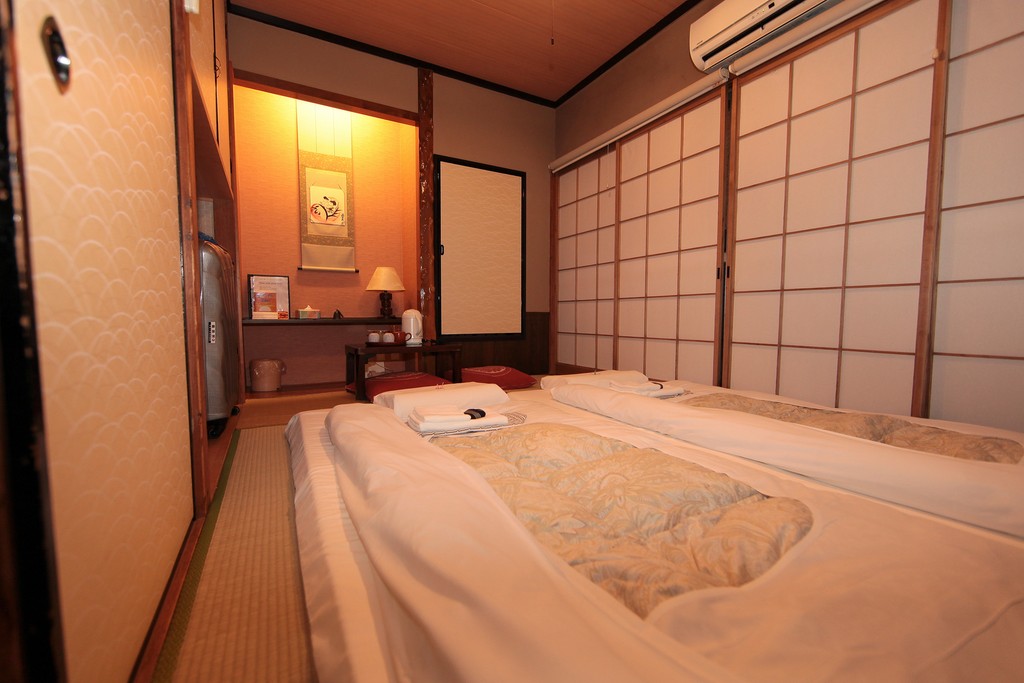RYOKAN AUBERGE JAPONAISE
Les ryokan (旅館) sont des auberges typiques du Japon. Il en existe environ 70 000 dont 1 800 sont qualifiés comme établissement membre de la Japan Ryokan Association. Il y a également environ 80 auberges membres du Japan Inn Group, spécialisées dans l’accueil des touristes venant de l’étranger.
Description
Les ryokan sont souvent constitués de matériaux typiques : bois, bambou, cloisons de papier, portes coulissantes. D'autres utilisent des matériaux plus modernes tout en gardant l'esthétisme japonais. Les chambres sont de grandes pièces munies de cloisons coulissantes (les shoji) et d’une table basse au milieu de la pièce. Le sol est généralement recouvert de tatamis constitués de paille de riz, les clients dorment sur un « futon » déroulé avant la nuit par les femmes de chambre. Les ryokan sont également munies de bains chauds. L’eau provient parfois de sources thermales situées sous le ryokan. On parle alors d’onsen. Dans les ryokan les plus coûteux, le soir, après le repas, les femmes de chambre passent pour retirer la table basse et installer des futons pour la nuit. Les futons peuvent aussi être disposés avant l’arrivée des clients. Il est de coutume au Japon, d’enlever ses chaussures à l’entrée. Des chaussons sont à votre disposition pour vos déplacements à l’intérieur. Un vêtement d’intérieur porté dans les ryokans, le "yukata", kimono de coton à motifs bleus et blancs, est également mis à votre disposition.
-------------------------------------------
A ryokan (旅館) is a type of traditional Japanese inn that originated in the Edo period (1603–1868), when such inns served travelers along Japan's highways. They typically feature tatami-matted rooms, communal baths, and other public areas where visitors may wear yukata and talk with the owner.
Ryokan are difficult to find in Tokyo and other large cities because many are expensive compared to hotels, and Japanese people increasingly use hotels for urban tourism. Nonetheless, some major cities do have reasonably priced ryokan, with some costing as little as $40 a night. However, ryokan are more typically located in scenic areas, such as in the mountains or by the sea, and in recent years many ryokan have been redeveloped to their original style particularly by resort chain Hoshino Resorts, whose first ryokan opened in Karuizawa in 1914.
Features
A typical ryokan has a relatively large entrance hall, with couches and chairs where guests can sit and talk; a modernized ryokan often has a television in the hall as well. Guest rooms are constructed using traditional Japanese methods: flooring is tatami, and doors are sliding doors. Even if the inn uses hinged doors for security, it usually opens into a small entranceway where guests can take off their shoes before stepping onto the tatami floor, which would be separated by a sliding door. Many ryokan rooms also feature a porch or balcony, also set off with a sliding door. Almost all ryokan feature common bathing areas or ofuro, usually segregated by gender, using the water from a hot spring (onsen) if any are nearby. (Areas with natural hot springs tend to attract high concentrations of ryokan). High-end ryokan may provide private bathing facilities as well. Typically ryokan provide guests with a yukata to wear; they might also have games such as table tennis, and possibly geta that visitors can borrow for strolls outside. Bedding is a futon spread out on the tatami floor. When guests first enter their room, they usually find a table and some supplies for making tea. The table is also used for meals when guests take them in their room. While guests are out, staff (usually called nakai) will move the table aside and set out the futon.
Meals
Most ryokan offer dinner and breakfast, which are often included in the price of the room. Most visitors do take their meals at the ryokan, which usually promote themselves on the quality of their food. Meals consist of traditional Japanese cuisine known as kaiseki, which features seasonal and regional specialties. (Kaiseki originally referred to light meals served during a tea ceremony, and today refers to a meal consisting of a number of small, varied dishes.) In order for each dish to be enjoyed at the proper temperature, ryokan stress that guests should be punctual for their meals. For this reason, most ryokan ask guests to confirm the time they want to take their meals. Some ryokan have a communal dining area, but most serve meals in the guests' rooms. Ryokan which are likely to serve non-Japanese guests may also have a selection of Western food.
